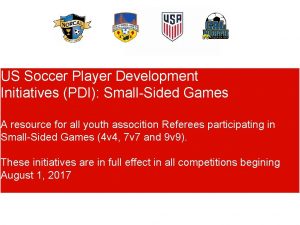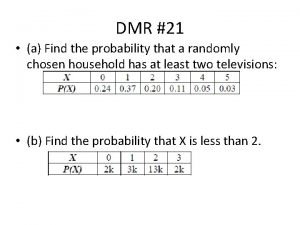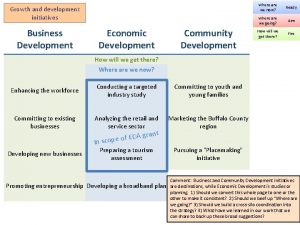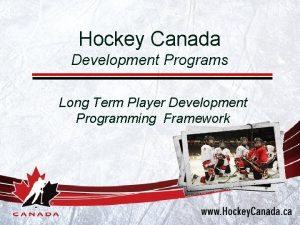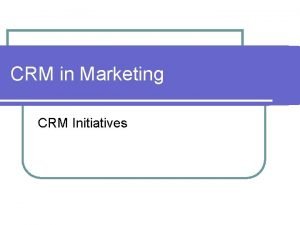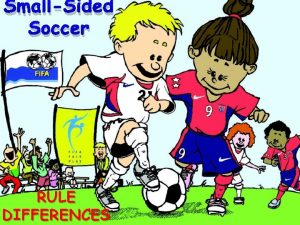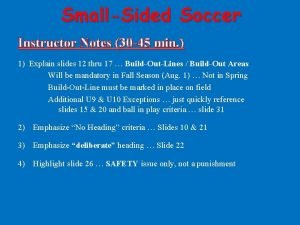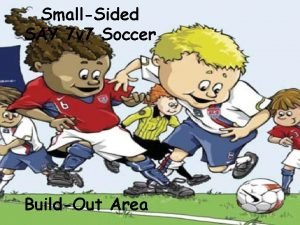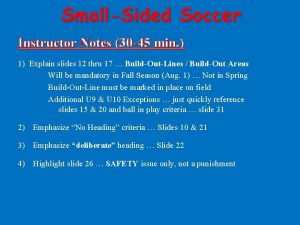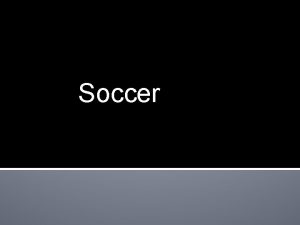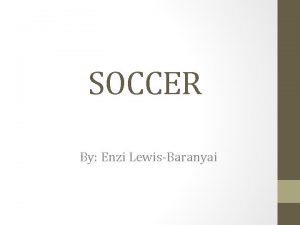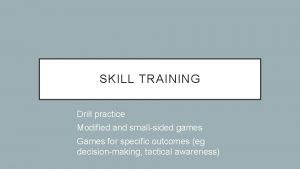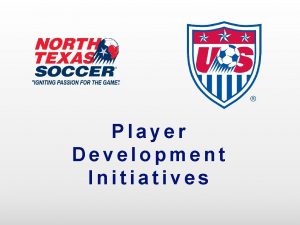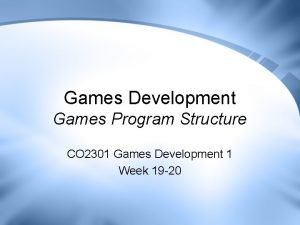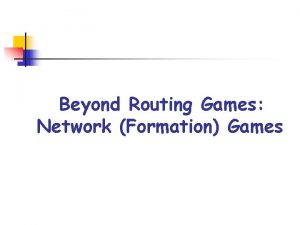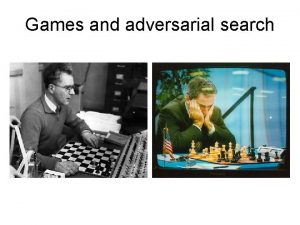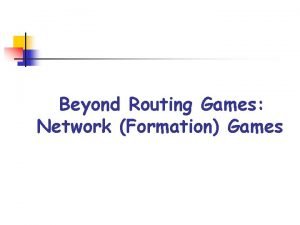US Soccer Player Development Initiatives PDI SmallSided Games
































- Slides: 32

US Soccer Player Development Initiatives (PDI): Small-Sided Games A resource for all youth assocition Referees participating in Small-Sided Games (4 v 4, 7 v 7 and 9 v 9). These initiatives are in full effect in all competitions begining August 1, 2017

How to Best Support these Changes • Have patience: Referees, coaches and players will be learning and better understanding these new small sided rules together and over time. • Review the Rules Regularly. Discuss them with your fellow referees. Discuss them with coaches that are also learning these new and specialized rules. • Enforce the Laws and Rules of Competition. Do not refrain from doing so, this will cause problems for everyones development in understanding and implementing the Laws/Rules in future matches. • Communicate with and get answers from your local members and leaders. Refer to your assignors, CNRA leaders and CNRA resources being developed online.

Objectives For ALL Small-Sided Games • Develop improved skills with the ball • Improve confidence and comfort • Develop intelligence with and without the ball • Promote faster decisions and better awareness • Develop partnerships within the team • Provide an age appropriate environment • Standards align with physiological needs of players based on year of birth Uniformity across the country and across membership • Similar to the outcomes listed for birth year registration, having consistent standards allows U. S Soccer, and the programs of our members, to provide more meaningful messaging and education for parents, players, coaches and referees

Small-Sided Games Chart U 06 (4 v 4) Field Size (yards) Goal Size Ball Size Players Game Time Offside GK Punt Dist. Free Kicks Penalty Kicks Free. Kicks U 07 (4 v 4) U 08 (4 v 4) U 09 (7 v 7) U 10 (7 v 7) U 11(9 v 9) U 12 (9 v 9) Length 25 - Length 55 - Length 7035 35 35 65 65 80 80 Width 15 -25 Width 35 -45 Width 45 -55 Height 4 ft. Width 6 ft. Height 4 ft. Height 6. 5 ft. Height 7 ft. Width 6 ft. Width 18. 5 ft. Width 21 ft. Height 7 ft. Width 21 ft. 3 3 3 4 4 4 v 4 7 v 7 9 v 9 4 x 10 min. 2 x 25 min. 2 x 30 min. No No No Yes Yes No No No Yes 10 feet 8 yards No (IFK) Yes(10 yards) IFK ONLY IFK/DFK General

US Soccer Player Development Initiatives (PDI): 4 v 4 Small-Sided Games

4 v 4 Standards of Play • Registered and certified referees are not needed at this level • Since there is no referee, coaches are expected to manage the game environment from the touchline using these standards of play and their best judgement • Together, coaches and parents are expected to create and promote a fun and safe environment for the players

4 v 4 Standards of Play • Kick offs, free kicks, throw-ins, goal kicks and corner kicks are used to start or restart play • Kick-ins and/or dribble-ins are also acceptable • Goal kicks and corner kicks should be taken in the general vicinity of the respective goal or corner • If used, all free kicks are indirect • Opponents should be 10 feet away from the ball on all restarts • No penalty kicks • No offside

4 v 4 Standards of Play • Size 3 ball • 4 v 4 (no goalkeepers) • Shin guards are required • Substitutions are unlimited and can occur at any time - “on the fly” • 4 quarters • No more than 10 minute quarters • 5 minute breaks between quarters • Playing times can be less than 10 minutes when managed by the coaches and parents

Field • 25 -35 yards (length) • 15 -25 yards (width) • Goals should be no larger than 4 feet (height) x 6 feet (width) • Corner flags are not needed

4 v 4 Player Development Philosophy • Formal rosters and teams are not needed so having a flexible and fluid approach to training and playing is recommended • While playing, everyone should participate a minimum of 50% of the time • With 4 players on the field, having 6 players on each “team” when the “game” is played helps maximize participation and engagement • Results and standings should not be recorded • Remember that safety and fun are the top priorities so make adjustments as needed to ensure both are being promoted

4 v 4 Concussion Initiative • Per U. S. Soccer’s Concussion Initiative, if a player is suspected to have a head injury the referee* is instructed to stop play to allow for treatment/evaluation as needed If the player leaves the field of play for additional evaluation, a substitution can be made in that moment • The player with the suspected head injury may not return to the game unless a Health Care Professional (HCP) or Certified Athletic Trainer (ATC) has cleared the player Any coach or parent insisting on returning the player to the game without approved clearance will result in the referee* ending the game • Since there is no referee in 4 v 4, this responsibility falls to the coaches and parents involved • Deliberate heading is not allowed in 4 v 4 games • If a player deliberately heads the ball in a game, an indirect free kick should be awarded to the opposing team from the spot of the offense

US Soccer Player Development Initiatives (PDI): 7 v 7 Small-Sided Games

7 v 7 Player and Referee Development Philosophy • Game day rosters should include no more than 12 players (Confirm with your Rules of Competition) • Results and standings should not be recorded. (CNRA still requires referees to record goals and misconducts for themselves to develop this skill set. ) • Enforce proper Substitution Procedures. (CNRA requires referees to enforce proper substitution procedures at all levels of play. Players and Referees must develop understanding and application of these procedures. Referees must eliminate risks of too many players on the field and to recognize players entering and departing the field to adjust their awareness of certain players and tactics. )

7 v 7 Concussion Initiative Rules of Competition: Deliberate Heading • Deliberate heading is not allowed in 7 v 7 games. (Do not penalize inadvertent contact of ball to head. Referees should only stop play if they have concern of potential injury in which case the restart must be a dropped ball. ) • If a player deliberately heads the ball in a game, an indirect free kick should be awarded to the opposing team from the spot of the offense • If the deliberate header occurs within the goal area, the indirect free kick should be taken on the goal area line parallel to the goal line at the nearest point to where the infringement occurred • US Soccer does not deem a deliberate header a FOUL and instead lists it as a technical offense. Referees are not to penalize players with a caution for persistently infringing this law. (Similar to Offside) • Also, deliberate heading of the ball, since it is NOT deemed a FOUL and instead only a technical offense, may not be penalized with any degree of misconduct for denying a goal or goal scoring opportunity. If this occurs, only award an Indirect Free Kick to the opponent and do not issue a misconduct to the offender.


7 v 7 Standards of Play Build Out Line and GK possession • The build out line promotes playing the ball out of the back in a less pressured setting • When the goalkeeper has the ball in his or her hands during play, the opposing team must move behind the build out line until the ball is put into play • Once the opposing team is behind the build out line, the goalkeeper can pass, throw or roll the ball into play. • After the ball is put into play by the goalkeeper, the opposing team can cross the build out line and play resumes as normal • Ideally, the goalkeeper will wait to put the ball into play once all opponents are past the build out line, however, the goalkeeper can put the ball into play sooner but he or she does so accepting the positioning of the opponents and the consequences of how play resumes

7 v 7 Standards of Play Build Out Line and No Punting • Punts and drop kicks are not allowed. • If a goalkeeper punts or drop kicks the ball, an indirect free kick should be awarded to the opposing team from the spot of the offense • If the punt or drop kick occurs within the goal area, the indirect free kick should be taken on the goal area line parallel to the goal line at the nearest point to where the infringement occurred • Referees should not caution goal keepers for persistent infringement when repeating this punting offense. (Similar to offside and deliberately heading offenses) However, if the referee deems it is a tactic to delay the game, they may caution the goal keeper for this misconduct.

7 v 7 Standards of Play Build Out Line and Goal Kicks • Goal kicks are to be taken within the goal area. • The opposing team must move behind the build out line until the ball is in play. The ball is in play when it has whole left the penalty area. • Ideally, the team taking the goal kick will wait to put the ball into play once all opponents are past the build out line, however, they may choose to put the ball into play sooner but he or she does so accepting the positioning of the opponents and the consequences of how play resumes.

7 v 7 Standards of Play Build Out Line and Offside • The build out line will also be used to denote where offside offenses can be called • Players cannot be penalized for an offside offense between the halfway line and the build out line • Players can be penalized for an offside offense between the build out line and goal line

7 v 7 Build Out Line Practical Applications • To support the intent of the development rule, coaches and referees should be mindful of any intentional delays being caused by opponents not retreating in a timely manner or encroaching over the build out line prior to the ball being put into play • Coaches are responsible for addressing these types of issues with their players • Referees can manage the situation with misconduct if deemed appropriate • Referees should be flexible when enforcing the 6 second rule. • The counting the time of possession should only begin when all opponents have moved behind the build out line

7 v 7 Standards of Play Modified Laws of the Game Law 1 – Field of Play • 55 -65 yards (length) • 35 -45 yards (width) • Goals should be no larger than 6. 5 feet (height) x 18. 5 feet (width) • A 6. 5 feet (height) x 12 feet (width) goal is recommended based on the age and ability of the players • Diagram contains recommended field markings and dimensions • Build out lines should be equidistant between the penalty area line and halfway line. There is no designated distance due to the range of size of fields • If a turf field is used or if lines can not be marked, cones may be placed off the field to determine an “imaginary” buildout line

7 v 7 Standards of Play Modified Laws of the Game Law 2 – Ball • Size 4 Law 3 – Players • 7 v 7 (6 field players and 1 goalkeeper) • Game may not start or continue if there are less than 5 players on a team • Substitutions are unlimited and can occur at any stoppage Law 5 – Referee • Minimum certification as a U. S. Soccer Grade 9 Referee Law 6 – Other Match Officials • Used at the discretion of the competition Law 7 – Duration of the Match • 2 halves • 25 minutes halves • 10 minute halftime • No added time

7 v 7 Standards of Play Standard Laws of the Game Law 4 – Players’ Equipment Law 8 – Start and Restart of Play Law 9 – Ball In and Out of Play Law 10 – Method of Scoring Law 11 – Offside Law 12 – Fouls and Misconduct* Law 13 – Free Kicks (opponents are required to be minimum of 8 -yards from all free-kicks) Law 14 – Penalty Kick Law 15 – Throw-in Law 16 – Goal Kick Law 17 – Corner kick *With the exception of “deliberate heading” and “GK punting” where these are “technical offenses” where restart is an indirect free kick.

7 v 7 Concussion Initiative • Per U. S. Soccer’s Concussion Initiative, if a player is suspected to have a head injury the referee is instructed to stop play to allow for treatment/evaluation as needed If the player leaves the field of play for additional evaluation, a substitution can be made in that moment • The player with the suspected head injury may not return to the game unless a Health Care Professional (HCP) or Certified Athletic Trainer (ATC) has cleared the player Any coach or parent insisting on returning the player to the game without approved clearance will result in the referee ending the game

US Soccer Player Development Initiatives (PDI): 9 v 9 Small-Sided Games

9 v 9 Player Development Philosophy • Game day rosters should include no more than 16 players. (Confirm with Rules of Competition) • Results and standings should not be recorded • Events (ex: tournaments, showcases, festivals, etc. ) should provide a predetermined number of games with no advancement, placement games or champions

9 v 9 Concussion Initiative • Deliberate heading is not allowed in U 11 games. USSoccer does allow Heading in U 12 games without limitations. HOWEVER, League Associations are empowered to limit or ban heading at this level of play or higher. Referees are to be aware of League Rules of Competition • If a player deliberately heads the ball in a game, an indirect free kick should be awarded to the opposing team from the spot of the offense. (Do not penalize inadvertent contact of ball to head. Referees should only stop play if they have concern of potential injury in which case the restart must be a dropped ball. ) • If the deliberate header occurs within the goal area, the indirect free kick should be taken on the goal area line parallel to the goal line at the nearest point to where the infringement occurred

9 v 9 Standards of Play Modified Laws of the Game Law 1 – Field of Play • 70 -80 yards (length) • 45 -55 yards (width) • Goals should be no larger than 7 feet (height) x 21 feet (width) • A 6. 5 feet (height) x 18. 5 feet (width) goal is recommended based on the age and ability of the players • Diagram contains recommended field markings and dimensions


9 v 9 Standards of Play Modified Laws of the Game Law 2 – Ball • Size 4 Law 3 – Number of Players • 9 v 9 (8 field players and 1 goalkeeper) • Game may not start or continue if there are less than 6 players on a team • Substitutions are unlimited and can occur at any stoppage Law 5 – Referee • Minimum certification as a U. S. Soccer Grade 9 Referee Law 6 – Other Match Officials • Used at the discretion of the competition authority Law 7 – Duration of the Match • 2 halves • 30 minutes halves • 10 minute halftime • No added time

9 v 9 Standards of Play Standard Laws of the Game Law 4 – Players’ Equipment Law 5 – The Referee Law 8 – Start and Restart of Play Law 9 – Ball In and Out of Play Law 10 – Method of Scoring Law 11 – Offside Law 12 – Fouls and Misconduct* ** Law 13 – Free kicks (opponents are required to be minimum of 8 -yards from all free-kicks) Law 14 – Penalty Kick Law 15 – Throw-in Law 16 – Goal kick Law 17– Corner kick *With the exception of deliberate heading in U 11 games **Associations may enforce no deliberate heading with U 12 or older (Check your League Rules of Competition)

9 v 9 Concussion Initiative • Per U. S. Soccer’s Concussion Initiative, if a player is suspected to have a head injury the referee is instructed to stop play to allow for treatment/evaluation as needed • If the player leaves the field of play for additional evaluation, a substitution can be made in that moment • The player with the suspected head injury may not return to the game unless a Health Care Professional (HCP) or Certified Athletic Trainer (ATC) has cleared the player • Any coach or parent insisting on returning the player to the game without approved clearance will result in the referee ending the game
 Us soccer pdi
Us soccer pdi Pdi development pipeline
Pdi development pipeline A professional soccer player succeeds in scoring
A professional soccer player succeeds in scoring Business development initiatives
Business development initiatives Types of main idea
Types of main idea Soccer players learn many skills when playing soccer
Soccer players learn many skills when playing soccer Formato anexo 1
Formato anexo 1 Pbı nedir
Pbı nedir Pdi profilor 360 assessment
Pdi profilor 360 assessment Pdi uema
Pdi uema Calibrar pizarra promethean
Calibrar pizarra promethean Pdi idv mas uai lto
Pdi idv mas uai lto Cytochine
Cytochine Pdi définition
Pdi définition Vicerrectorado pdi ugr
Vicerrectorado pdi ugr Pdi cell signaling
Pdi cell signaling Gerard hendrik hofstede
Gerard hendrik hofstede Pas pdi
Pas pdi Chapter 7 hunger games questions
Chapter 7 hunger games questions Types of games outdoor
Types of games outdoor Hockey canada long term player development
Hockey canada long term player development Delvic sanitation initiatives
Delvic sanitation initiatives Digital initiatives in higher education
Digital initiatives in higher education Crm marketing initiatives
Crm marketing initiatives How do empathy theories prevent discrimination
How do empathy theories prevent discrimination People's initiatives
People's initiatives It software management initiatives
It software management initiatives Health initiatives
Health initiatives Service desk improvement initiatives
Service desk improvement initiatives Global health initiatives meaning
Global health initiatives meaning Work life balance initiatives
Work life balance initiatives Faa strategic initiatives
Faa strategic initiatives Oakland affordable housing preservation initiatives
Oakland affordable housing preservation initiatives
